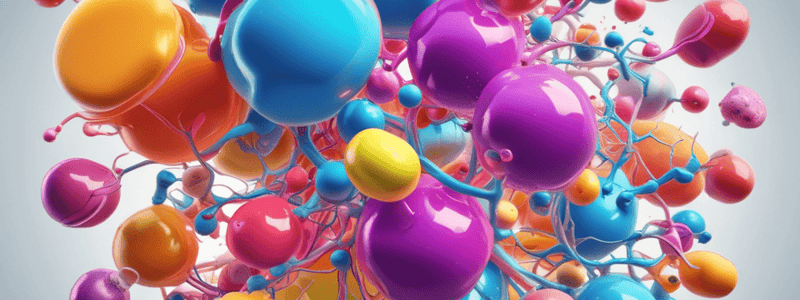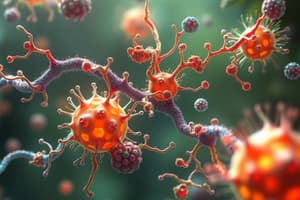Podcast
Questions and Answers
In the Calvin Cycle, which molecule is used to initially fix carbon from CO2?
In the Calvin Cycle, which molecule is used to initially fix carbon from CO2?
- Ribulose-1,5-bisphosphate (RuBP) (correct)
- 3-Phosphoglycerate
- Fructose-1,6-bisphosphate
- Glyceraldehyde-3-phosphate (G3P)
Which of the following is NOT a product of the light reactions in photosynthesis?
Which of the following is NOT a product of the light reactions in photosynthesis?
- Oxygen
- Glyceraldehyde-3-phosphate (G3P) (correct)
- NADPH
- ATP
In cellular respiration, which process generates the most ATP per glucose molecule?
In cellular respiration, which process generates the most ATP per glucose molecule?
- Citric acid cycle
- Oxidative phosphorylation (correct)
- Pyruvate oxidation
- Glycolysis
Which of the following is NOT a function of the electron transport chain in cellular respiration?
Which of the following is NOT a function of the electron transport chain in cellular respiration?
In the absence of oxygen, what process allows glycolysis to continue by recycling NADH back to NAD+?
In the absence of oxygen, what process allows glycolysis to continue by recycling NADH back to NAD+?
Which of the following is NOT a potential substrate for cellular respiration when glucose is unavailable?
Which of the following is NOT a potential substrate for cellular respiration when glucose is unavailable?
In the Calvin Cycle, what is the primary function of the regeneration phase?
In the Calvin Cycle, what is the primary function of the regeneration phase?
In glycolysis, which of the following is considered the 'investment phase'?
In glycolysis, which of the following is considered the 'investment phase'?
In the citric acid cycle, which of the following is NOT a product?
In the citric acid cycle, which of the following is NOT a product?
Which of the following is the final electron acceptor in the electron transport chain during aerobic respiration?
Which of the following is the final electron acceptor in the electron transport chain during aerobic respiration?
Which of the following best describes the relationship between anabolic and catabolic reactions in metabolism?
Which of the following best describes the relationship between anabolic and catabolic reactions in metabolism?
According to the Second Law of Thermodynamics, what happens to the entropy of a system during a spontaneous reaction?
According to the Second Law of Thermodynamics, what happens to the entropy of a system during a spontaneous reaction?
What is the relationship between free energy (G) and the other thermodynamic quantities, enthalpy (H) and entropy (S)?
What is the relationship between free energy (G) and the other thermodynamic quantities, enthalpy (H) and entropy (S)?
Which of the following statements best describes the role of enzymes in biochemical reactions?
Which of the following statements best describes the role of enzymes in biochemical reactions?
How do substrates interact with enzymes during a catalyzed reaction?
How do substrates interact with enzymes during a catalyzed reaction?
Which of the following is the primary factor that determines the specificity and function of an enzyme?
Which of the following is the primary factor that determines the specificity and function of an enzyme?
What is the relationship between the direction of change in free energy (G) and the spontaneity of a reaction?
What is the relationship between the direction of change in free energy (G) and the spontaneity of a reaction?
How do anabolic and catabolic reactions differ in terms of their effect on the energy level of the products?
How do anabolic and catabolic reactions differ in terms of their effect on the energy level of the products?
What is the relationship between the spontaneity of a reaction and the change in entropy of the system?
What is the relationship between the spontaneity of a reaction and the change in entropy of the system?
How do anabolic and catabolic reactions differ in terms of their energy requirements?
How do anabolic and catabolic reactions differ in terms of their energy requirements?
Which of the following accurately describes the role of enzymes in cellular processes?
Which of the following accurately describes the role of enzymes in cellular processes?
Which of the following statements accurately describes the relationship between enthalpy, entropy, and free energy in chemical reactions?
Which of the following statements accurately describes the relationship between enthalpy, entropy, and free energy in chemical reactions?
Which of the following statements accurately describes the difference between anabolic and catabolic reactions?
Which of the following statements accurately describes the difference between anabolic and catabolic reactions?
Which of the following statements accurately describes the role of reaction coupling in cellular processes?
Which of the following statements accurately describes the role of reaction coupling in cellular processes?
Which of the following statements accurately describes the role of ATP in cellular processes?
Which of the following statements accurately describes the role of ATP in cellular processes?
Which of the following statements accurately describes the role of NADH and NADPH in cellular processes?
Which of the following statements accurately describes the role of NADH and NADPH in cellular processes?
Which of the following statements accurately describes the role of the light reactions in photosynthesis?
Which of the following statements accurately describes the role of the light reactions in photosynthesis?
Which of the following statements accurately describes the role of the electron transport chain (ETC) in the light reactions of photosynthesis?
Which of the following statements accurately describes the role of the electron transport chain (ETC) in the light reactions of photosynthesis?
Flashcards
Allosteric Effectors
Allosteric Effectors
Binding at a site other than the active site, altering enzyme shape to inhibit or activate function.
Reaction Coupling
Reaction Coupling
Combining a positive ΔG reaction with a negative ΔG reaction resulting in a net negative ΔG.
Oxidation
Oxidation
Losing electrons during a chemical reaction.
Reduction
Reduction
Signup and view all the flashcards
NADH (or NADPH)
NADH (or NADPH)
Signup and view all the flashcards
Laws of Thermodynamics
Laws of Thermodynamics
Signup and view all the flashcards
Free Energy (G)
Free Energy (G)
Signup and view all the flashcards
Photosynthesis
Photosynthesis
Signup and view all the flashcards
Cellular Respiration
Cellular Respiration
Signup and view all the flashcards
Glycolysis
Glycolysis
Signup and view all the flashcards
Citric Acid Cycle
Citric Acid Cycle
Signup and view all the flashcards
Electron Transport Chain
Electron Transport Chain
Signup and view all the flashcards
Metabolism
Metabolism
Signup and view all the flashcards
Anabolic Reactions
Anabolic Reactions
Signup and view all the flashcards
Catabolic Reactions
Catabolic Reactions
Signup and view all the flashcards
Study Notes
Enzyme Regulation
- Allosteric effectors bind to enzymes at sites other than the active site, altering the protein's shape to inhibit or activate enzyme function
- Metabolic pathways can be regulated at different steps depending on cellular demands
- Negative feedback loops use pathway products to inhibit enzymes at the beginning of the pathway
Energy Transformations
- Positive ΔG reactions are accomplished through reaction coupling, combining a positive ΔG reaction with a negative ΔG reaction to yield a net negative ΔG
- The most common means of reaction coupling uses ATP hydrolysis to generate phosphorylated intermediate molecules of higher energy
- ATP is continuously used and regenerated from ADP + Pi
Redox Reactions
- Oxidation is the loss of electrons, while reduction is the gain of electrons by molecules
- NADH (or NADPH) is a high-energy electron carrier in metabolism, capturing high-energy electrons and holding them for later use in electron transport chains
Thermodynamics
- The First and Second Laws of Thermodynamics state that energy is transformed, but always at the cost of energy lost through entropy
- Free energy (G) is chemical energy available to do work, expressed as the difference between enthalpy (total energy) and entropy
- Any reaction involves a change in free energy, ΔG, between reactants and products
- The direction of change in free energy indicates if it is positive or negative ΔG (anabolic or catabolic)
Photosynthesis
- Photosynthesis transforms light energy into chemical energy, synthesizing new carbon backbones from CO2
- In eukaryotes, photosynthesis occurs in chloroplasts, using components in the stroma, thylakoid membranes, and thylakoid lumen
- The light reactions use two photosystems to capture light and generate high-energy electrons
- The Calvin Cycle fixes inorganic carbon from CO2 into organic carbon chains, storing energy in chemical bonds
Cellular Respiration
- Cellular respiration breaks down glucose to make ATP using substrate-level and oxidative phosphorylation
- The process begins with glycolysis, which uses glucose to make 2 ATP, 2 NADH, and 2 pyruvate
- The citric acid cycle oxidizes acetyl-CoA to CO2, making 2 ATP, 6 NADH, and 2 FADH2
- The electron transport chain donates high-energy electrons, generating proton motive force and producing ATP through chemiosmosis
Metabolism
- Metabolism is the sum of all anabolic and catabolic reactions in a cell, connected in a network of reaction pathways
- Anabolic reactions synthesize or "build" molecules with more bonds, using or storing energy (endergonic), reducing entropy, and being non-spontaneous
- Catabolic reactions degrade or "break" molecules, increasing entropy and releasing energy (exergonic), and being spontaneous
Studying That Suits You
Use AI to generate personalized quizzes and flashcards to suit your learning preferences.




